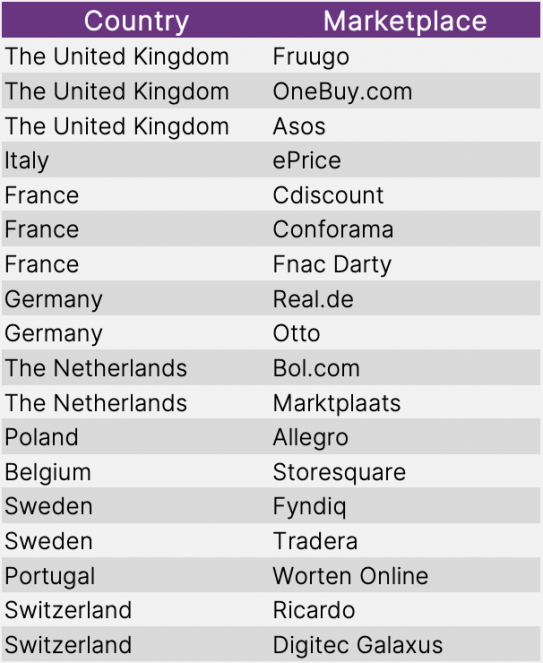
MDM for Marketplaces
Learn about how to make the most out of marketplaces by extending your reach and mastering your data management processes.
INTRODUCTION
Marketplaces are rapidly growing in popularity as an essential part of E-commerce. When people shop online, more often than not, they start their search on a digital marketplace rather than through Google or another search engine. As a result, the number of online marketplaces has exploded in recent years.
As a retailer or brand, marketplaces offer enormous potential for broadening your horizon and selling to people in different parts of the world. But even if you are less ambitious, it’s becoming increasingly hard to run a successful business without maintaining a presence on these marketplaces. Simply operating your own webshop is no longer sufficient. In this page, we’ll go in-depth into how to start selling in Marketplaces.
Get started with marketplaces
What are Marketplaces?
An online marketplace is a website that allows customers to shop for various products from many different vendors that actively sell their products on their e-commerce platform. This way, a marketplace is able to offer a wide range of products – much more diverse than anything a regular store could possibly offer – making it an attractive place for online shoppers. Since the marketplace (mostly) does not own the inventory offered by external vendors, it simply facilitates the sale.
Despite the fact that all digital marketplaces follow this principle, they still come in many shapes and forms. A marketplace can be focused on offering a varied selection of products to a large and diverse customer base, aim to serve a certain niche market, or even focus on customer-to-customer sales like Marktplaats in The Netherlands.
Currently, Europe is home to many different marketplaces; Amazon, eBay, and Zalando are well known throughout Europe, but most countries also have their own local marketplace(s). In the Netherlands for example, Bol.com has a significant market share.
The following overview provides a sneak peek of the many different marketplaces out there in Europe.

Define your strategy for selling on Marketplaces
Customers demand to be able to shop how and where they want, but at the same time also expect comparable shopping experiences regardless of the platform they to choose to visit. Having a clearly defined strategy for selling on marketplaces is essential, and should be part of your broader channel strategy.
Before you start selling your products on marketplaces, you have to ask yourself what your main driver is. What are the exact goals you want to achieve? Do you want to reach your existing customers through marketplaces too? Or is the purpose to expand your customer segments and start selling in new countries?
The answers to these questions should shape and define your marketplace strategy. If, for example, you decide to sell your products on a large multi-segment marketplace, which also increases visibility to your existing customers, how much sales are you willing to lose on your own website in favour of sales on a marketplace?
In order to ensure your presence on marketplaces is a success, you also have to consider the assortment of products you are going to sell, with special attention to both the actual number and selection of products. To make it on a marketplace, it is important to understand how its algorithms decide which products appear at the top of each page or in search results. If, for example, the introduction date plays a large role in deciding visibility, you need to think about the exact moment you add a product to the marketplace. On the other hand, if sales per seller are more important to the algorithm, it could pay off to focus on offering more diverse products in that specific marketplace.
After you have decided on your strategy it’s time for the hard part: managing all those sales. You need to set up a good customer service and return policies, amongst others, especially when expanding your horizon to different markets and new countries. Your own customer services become even more important if you opt to sell on non-full-service marketplaces. But even if you have the logistics and services in place, selling on marketplaces is a challenging undertaking.
MDM/PIM for Marketplaces
Data Management for Marketplaces
When customers shop online, product data is essential for providing them with a quality experience. Data can make or break a sale. Without providing high quality, complete, consistent, and accurate data, selling online is going to be an uphill battle. On a marketplace, matching your products with high-quality data allows you to stand out between competitors that sell the same or similar products, and ensures your products are included when customers start a relevant search.
Managing all this product data is no small task. Especially if you have an extensive catalogue and sell through multiple channels in different countries. Since marketplaces each have their own demands regarding product data, and how this data should be presented, managing all this information is made even more complex.
Introducing a Product Information Management (PIM) system or a Master Data Management (MDM) system to your e-commerce ecosystem allows you to face these challenges head on, and guarantees your marketplace strategy leads to success. A PIM or MDM solution provides you with the tools to manage all your product data in one place; allowing you to manage the necessary characteristics for each product, save all information in the languages you need, maintain different assortments per sales channel, and much more. From this solid foundation you can easily publish your product data to all your channels with confidence, including marketplaces, knowing it is up-to-date and relevant.
SQLI's Expertise
Bring in an experienced partner
If you're unsure about whether your organization is ready to join a marketplace, bring in an experienced digital partner.
We have years of experience implementing MDM/PIM solutions and know exactly what to look out for, and can warn you about pitfalls we’ve experienced ourselves while working with these platforms and help you make sure your project is successful, within the planned time and budget.

Whitepaper
The choice for MDM: building the business case
Learn how to follow Gartner's 8-step framework to create a solid business case for your MDM solution, how to establish strategy, KPIs and capabilities as well as how to calculate the ROI of MDM.


